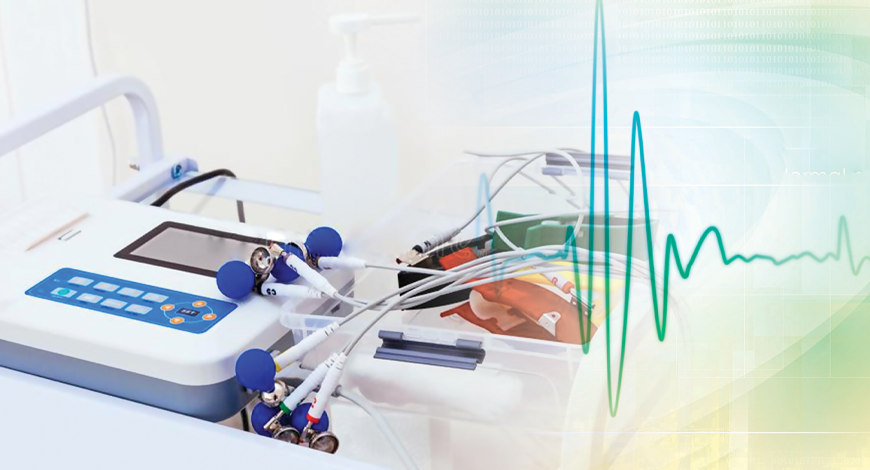ECG Equipment
ECG gaining a technical edge

The new-generation ECG devices incorporate advanced algorithms and various workflow-improvement features, such as simplified step-by-step operation, touchscreen systems, and better connectivity with CVIS, EMRs, and ECG-management systems.
The global diagnostic ECG equipment market is expected to reach USD 10.3 billion by 2024 from USD 7.5 billion in 2019, at a CAGR of 6.4 percent, predicts MarketsandMarkets. Increase in prevalence of heart diseases worldwide is the primary factor driving the ECG market globally. In many of the developing countries, owing to the cost-effective factor, physicians are forced to use traditional ECG devices instead of the latest high-end devices. Hence, high cost for buying and maintaining, and lack of technical skills are hindering the growth of the market in developing regions. In developed regions, because of already well-established infrastructure, the new sales are almost equal to the replacement rate.
The resting ECG devices segment will account for the highest ECG devices market share, by product. The increasing focus on early diagnosis and disease prevention, the rising number of resting ECG procedures, and technological advances are driving the growth of this market segment.
Technological advancements in sensors have enabled the development of wearable devices that can monitor and record cardiac impulses for long durations. In the absence of conventional ECG machines, such devices can be used in out-of-hospital settings like households and public places. The emergence of handheld, wireless, and remote-monitoring ECG devices will be one of the critical ECG devices market trends responsible for the growth of the market in coming years.
Technology trends
The ECG devices market has witnessed several technological advancements, which have reduced the size, enhanced portability, and simplified the use of ECG devices. The new-generation ECG devices incorporate advanced algorithms and various workflow improvement features, such as simplified step-by-step operation, touchscreen systems, and better connectivity with CVIS, EMRs, and ECG-management systems. ECG electrodes have also undergone significant improvements in terms of design and interference during patient-monitoring procedures. The use of conductive textile has made ECG electrodes soft, flexible, and breathable. Such technological advances are expected to fuel the growth of the ECG devices market at a CAGR of over 6 percent over the next 5 years.
Current ECG systems now offer improved workflow efficiencies, greater interoperability, and integration into cardiovascular information systems (CVIS), vendor-agnostic integration of multiple vendors’ ECG system data, and mobile access to waveforms.
ECG-management system. While standard 12-lead ECG is the bread and butter of ECG assessments and the core of ECG-management system reporting, hospitals that use 15-lead pediatric ECG should make sure the systems can accommodate its reporting. With the rapidly expanding use of single-lead cardiac monitors and consumer-grade ECG devices and apps, reporting systems that can accommodate capture and report for these devices might be a consideration.
For office-based practices and smaller clinics that do not require a standalone ECG-management system, some vendors offer cloud ECG-management service as an extension of their CVIS or picture archiving and communication system (PACS). This can help reduce the costs of implementing an ECG-management system.
ECG wearables. With recent technological advances, cardiologists are prescribing a lot of single-channel, wearable ECG patches to their patients. Holter ECG data can be more accurate in analyzing complex ventricular ectopy, since Holter-type devices offer a choice of three, five, or seven leads, enabling multiple simultaneous views of cardiac electrical activity. With multiple leads for patients to wear, and more data to analyze, selection of the appropriate ECG monitoring device is paramount.
Some ECG wearables use more than a single lead, but they are larger, bulkier, may have external lead wires, and require more adhesive than single-lead devices. Single-channel ECG wearables are good at detecting the most commonly occurring arrhythmias such as atrial fibrillation (AFib), among others, making them an efficient, cost-effective, and patient-friendly choice for most conditions that physicians want to diagnose.
Usage and physician acceptance of the patches is increasing. Patients like them. Doctors like them. They are simple to use. With no wires, the devices are comfortable for patients and produce quality diagnostic yields. They are especially good for patients needing a longer-term monitor, like those who might have symptoms once or twice per week, with seven days’ worth of ECG recording that will catch it.
Third-party integration. With interoperability demands from healthcare reform, all vendors have made greater efforts to integrate with other vendors’ systems. This includes eliminating proprietary coding and using open standards, such as HL7 and DICOM. Some ECG-management-system vendors have offered systems built on open standards to start with, so they can easily integrate as a module into another vendor’s CVIS.
Mobile access to waveforms. Several vendors have added smartphone interoperability to their systems, so ECG waveforms can be sent for immediate review by a physician, regardless of where they are. This has had a particular impact on emergency patient evaluations, such as those presenting to the emergency department with chest pain or suspected ST-elevated myocardial infarction (STEMI). The rapid diagnosis on smartphones enables earlier activation in the catheterization lab, leading to better patient outcomes in STEMI cases. The technology is especially helpful to connect with cardiologists who are not near an ECG system workstation or are at home in off-hours. Several vendors now allow dynamic ECG waveforms to be displayed on an iPad for remote access to either read studies outside traditional workstations or for faster access to confirm suspected STEMI cases.
Some manufacturers have also collaborated vendors with third-party integration software to access dynamic ECG waveforms on remote smartphones or tablets.
Outlook
In the coming years, the ECG market trend will increasingly move toward new technology, focused on higher sampling frequency for better results, improved Wi-Fi transmission from the device, and quality display with more information. Also, the ECG device will be handier, enabling the user to carry it from one place to another.












